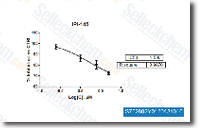As mentioned above, following the X ray complexes had been superimposed, some dif ferences emerged inside the side chain conformations of Thr231, Thr232 and Gln73, which indicates that these residues can move and rotate, with all the most notable motion occurring for Gln73, to far better accommodate the inhibitors. Furthermore, some anticipated flexibility was also observed in many residues lining the binding internet site cleft this kind of as Ile110 and Gly11 are situated within the S3 subpocket. The S3 and S1 pockets are contiguous in BACE one, as well as S3 pocket is rather hydrophobic in nature. A lot of inhibitors formed favor able contacts at this site within the S3 pocket, and this loca tion was considered to be a practical area to target in drug style. The extension of this pocket largely depends on the conformation of the 10S loop.
In the LDE225 structure comparative analysis from the BACE 1 X ray structures, it truly is clear that the 10S loop, a quick loop positioned in the base of the S3 sp, displays two major reduced energy confor mations, an open conformation as well as a closed conformation Tyr198 is found within the hydrophobic S2 pocket and also the hydrophobic S1 pocket. We uncovered the P2 moiety of some inhibitors totally fills the S2 pocket by using a benzyl ring. For the reason that of its restricted dimensions, the hydrophobic S1 pocket only seems to tolerate an alkyl or cycloalkyl chain using a greatest of three carbon atoms. This position was employed to achieve selective BACE inhibition and ought to be investigated further. It really is really worth noting that Tyr71 includes a tiny adverse PLS coefficient, highlighting the truth that the van der Waals interactions with this particular residue are somewhat correlated with activity.
Nevertheless, from the initially principal part, this residue may be the most important van der E7080 Waals interaction power variable. The PLS examination seeks variables that could give effective discrimination between weak and tight binders, and these variables never must be these using the higher absolute values, which means that dif ferences within the van der Waals interaction energies in volving Tyr71 cannot be used in the chemometric process for your purposes of correlation with variations in inhibitory potency. Hence, this interaction, despite the fact that crucial for binding, undoubtedly constitutes a rela tively compact contribution towards the inhibitory exercise.
With regards to the electrostatic block, it might be noticed in Figure 5B the damaging PLS coefficients for co existed using the beneficial PLS coefficients for Asp32, Gly34, Thr72, Tyr198 and Lys224, indicating that favor ready electrostatic interactions  with these residues are useful for action. As depicted in Figures 5 and 6, Asn233, Arg235 and Ser325, that are found within the S2 open region, can be either hydrophobic or polar. It was discovered that a sulfona mide or possibly a hydrophobic phenyl ring f the inhibitors can interact with these surrounding residues, suggesting that far more damaging or a lot more hydrophobic substituents are fa vorable on this area to improve the inhibitory action. o
with these residues are useful for action. As depicted in Figures 5 and 6, Asn233, Arg235 and Ser325, that are found within the S2 open region, can be either hydrophobic or polar. It was discovered that a sulfona mide or possibly a hydrophobic phenyl ring f the inhibitors can interact with these surrounding residues, suggesting that far more damaging or a lot more hydrophobic substituents are fa vorable on this area to improve the inhibitory action. o
FAK signal
FAK is activated by focal adhesion complex
